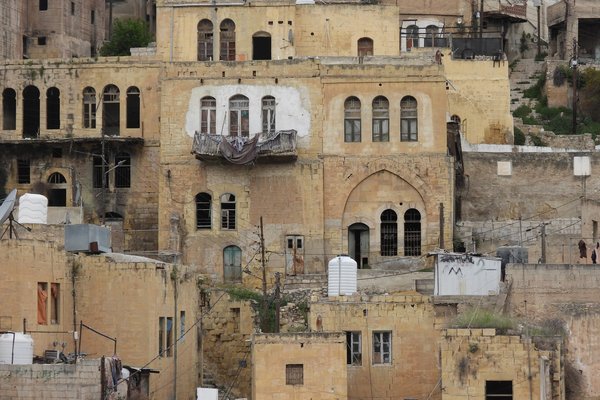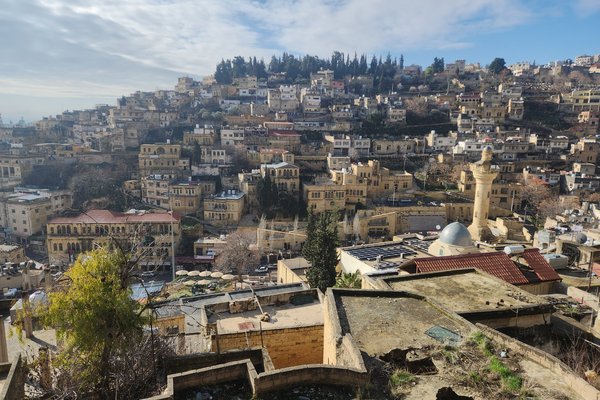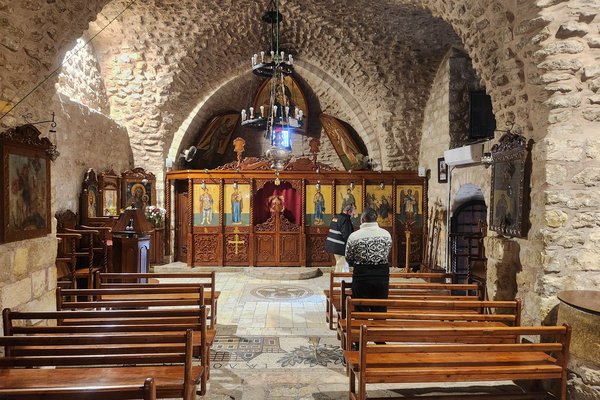Jordan
As-Salt
As-Salt - The Place of Tolerance and Urban Hospitality represents the city’s ‘Golden Age’ period (1860s to 1920s).
In the late Ottoman period the town saw an influx of traders from Nablus, Syria and Lebanon and it transformed into a thriving trade city. Architecturally elegant buildings were constructed, built in a mix of Ottoman tradition and the Nablusi style with honey-coloured local stone. Both Christian and Muslim communities lived here.
Community Perspective: The best place to start is the Historical Old Salt Museum in Abu Jaber House, which is probably the most famous expression of the new architectural style. Overall, As-Salt with its parked cars and open cables certainly isn’t a photogenic city and it may be hard to understand the OUV.
Site Info
Official Information
- Full Name
- As-Salt: The Place of Tolerance and Urban Hospitality (ID: 689)
- Country
- Jordan
- Status
-
Inscribed 2021
Site history
History of As-Salt
- 2021: Inscribed
- Inscribed
- 2020: Incomplete - not examined
- As: As-Salt: The Place of Tolerance and Urban Hospitality
- 2017: Deferred
- 2017: Advisory Body overruled
- ICOMOS suggested Not Inscribe. Overturned by amendment of Turkey to Deferral.
- 2015: Revision
- Successor to former TWHS Old City of Salt (2004)
- 1994: Deferred
- Bureau - require 1990 action plan to be adopted
- Type
- Cultural
- Criteria
- ii
- iii
Links
- UNESCO
- whc.unesco.org
- Official
-
- visitas-salt.com — The Story of As-Salt
- Related
-
- scholarworks.umass.edu — Master Thesis on Cultural Landscape of As-Salt
All Links
UNESCO.org
- whc.unesco.org — whc.unesco.org/
Official Website
- visitas-salt.com — The Story of As-Salt
Related Resources
- scholarworks.umass.edu — Master Thesis on Cultural Landscape of As-Salt
Community Information
- Community Category
- Urban landscape: Arabic and Middle Eastern
Travel Information
Amman Hotspot
Recent Connections
-
Clock Tower
There is a clock tower at the beginning… -
Amman Hotspot
30km, frequent public transport by mini… -
Bedouin
"The historic centre of As-Salt demonst…
Connections of As-Salt
- History
-
-
Ottoman Empire
As-Salt was a prominent frontier Ottoman trading centre between the mid-19th and early 20th centuries (AB ev) -
Located in a Former Capital
As-Salt was the capital of Transjordan before this was moved to Amman. (AB Ev) -
Fusion
The significant architecture within the historic city core emerged as a result of cultural exchange and circulation. The circulation of images, architectural types, building techniques and materials culminated in a cultural exchange that supported a new urban lifestyle new to As-Salt fused with local tribal/urban customs of urban hospitality and support and symbiosis between Muslim and Christian residents of the city. This is not only the circulation of architectural types, images, building techniques; but also the circulation of Modernity art such as the circulation of Art Nouveau paintings. (nom file p34)
-
- Architecture
-
-
Glazed tiles
Other typical materials include glazed ceramic tiles (AB ev) -
Reinforced Concrete
Reinforced concrete post & beam frame houses are cited as one of the contemporary architectural types in As-Salt. (nom file p40) -
Art Nouveau
A number of the 19th-century residences in the nominated property exhibit a blend of European Art Nouveau and Neo-Colonial styles (AB ev) -
Vernacular architecture
a mixture of vernacular regional and high-style architecture (AB ev)
-
- World Heritage Process
-
-
Ten years or more to inscribe
1994-2021
-
- Religion and Belief
-
-
Notable mosques
One prominent example which demonstrates the Ottoman diligence and interest in building mosques in the region is the building of the Small Mosque (Al-Jami' Al-Saghir) which was completed in 1907. It was built by the famous Nablusi master builder 'Abd al Rahman Al-'Aqruq and was located (...) very close to the main Sahet Al Ain at the center of the town. (Nomination text, p. 54) -
Protestantism
An Anglican Church was built in 1867 (AB ev)See universes.art
-
Greek Orthodox churches outside Greece
As-Salt has several Greek Orthodox churches: St. George's Church-Al Khader Church, Church of the Dormition of the Virgin Mary, Church of the Saviour-Church of the Lady Sarah (nom file p72) -
Christian Churches in non Christian countries
French missionaries built the Roman Catholic Church (known locally as Latin Church) in 1869-70 -> 4% Christians in Jordan (wiki)
-
- Human Activity
-
-
Bedouin
"The historic centre of As-Salt demonstrates distinctive intercultural exchanges that resulted in transformations of the Levant in the late Ottoman period. (...) These cultural exchanges involved the local Bedouin peoples, incoming merchants, craftspeople and traders, Ottoman officials and Christian missionaries. " (OUV) - During the city's 'Golden Age', local cultural traits and practices emerged from a fusion between local Bedouin cultures and migrating bourgeois merchants. (AB Ev)
-
- Constructions
-
-
Tombs
In the town of as-Salt and its environs are several Muslim shrines at the traditional tombs of the prophets Shu'ayb, Ayyoub, Yusha and Jadur, the Arabic names of the biblical characters Jethro, Job, Joshua and Gad. (wiki) -
Clock Tower
There is a clock tower at the beginning of the Souk, though it doesn't seem to have a name and isn't mentioned in the nom file either. It may be new.See www.flickr.com
-
Hospitals
Located on the Haddadin Steps overlooking Al Ain Plaza, the English Hospital was considered the only hospital in the region of Trans-Jordan in the second half of the 19th century (nom file p29)
-
- Timeline
-
-
Built in the 19th Century
Golden Age of As-Salt’s development between 1860s to 1920s. (AB ev)
-
- WHS Hotspots
-
-
Amman Hotspot
30km, frequent public transport by minibus
-
- WHS Names
-
-
Name changes
From "The Old City of As-Salt" over "As-Salt Eclectic Architecture (1865-1925), Origins and Evolution of an Architectural Language in the Levant" to the current name. (AB Ev) -
Epic Subtitles
The Place of Tolerance and Urban Hospitality
-
News
No news.
Recent Visitors
Visitors of As-Salt
- Alexander Lehmann
- Alexander Parsons
- Artur Anuszewski
- Bill Maurmann
- Bin
- Boj
- Cezar Grozavu
- Christravelblog
- Csaba Nováczky
- CugelVance
- Cyberczar
- David Berlanda
- Dimitrios Polychronopoulos
- Dr. Caligari
- Elena Y
- Els Slots
- Erik Jelinek
- Fmaiolo@yahoo.com
- Frédéric M
- George Gdanski
- Harry Mitsidis
- Hdhuntphotography
- henryjiao18
- Ivan Rucek
- Jana and Matt
- Jeffrey Chai
- KarenBMoore
- Kbecq
- KentishTownRocks
- Kevin McFarland
- Knut
- Loic Pedras
- Luboang
- Lucio
- Ludvan
- Luj3904
- Maciej Gil
- marcel staron
- MarcoB_0
- marc Rouserez
- Martin
- Martina Rúčková
- Mihai Dascalu
- Mikan22
- Mikko
- PabloNorte
- Patrik
- Paul Schofield
- Petteri
- Philipp Peterer
- Randi Thomsen
- Riccardo Quaranta
- Rick Ohm
- rogerding
- Roger Ourset
- Roman Raab
- Sandra!
- Stanislaw Warwas
- Svein Elias
- Szucs Tamas
- Tarquinio_Superbo
- Thomas Buechler
- Thomas van der Walt
- triath
- Vanessa Buechler
- Wojciech Fedoruk
Community Reviews
Show full reviews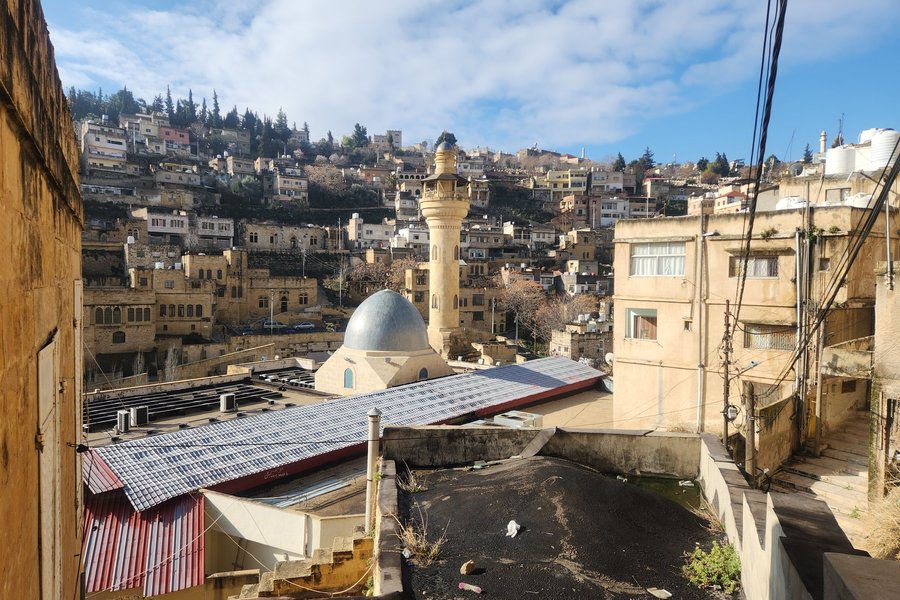
I visited As-Salt in February 2025 from Amman. By asking some very helpful men, I managed to find the very cheap minibus to As-Salt from the North bus terminal in Amman. The minibus dropped me off directly at the entrance to the city. For the return journey, the logistics were just as simple, but it's worth noting that the minibuses leave from down the hill, after the flea market.
I began my stroll through the city on Prince Hasan Bin Talal Street, where you'll find a few rather pretty buildings (the Mismar House at number 21, but see also the one at number 37 with its twisted columns). I then moved on to the city's most impressive mansion, the Abu Jaber Museum (on the left in the photo, with its reddish roof). Here you'll find a tourist information center and some rather uninteresting exhibits. The maps described by previous reviewers were only available in Arabic when I visited. I then climbed up to the Haj Hamdi Mosque Alanis to enjoy the plunging views over the city (photo). The amazement was not there, however. As-Salt isn't particularly pretty, with its faded buildings and exposed electric wires. The architecture and use of yellow stone didn't even strike me as harmonious. I then went back downstairs and visited St George's Church. The houses in the streets of this area are probably the prettiest in As-Salt, some with colorful shutters, doors or balconies. I continued with a visit to the souk on Al Hammam …
Keep reading 0 comments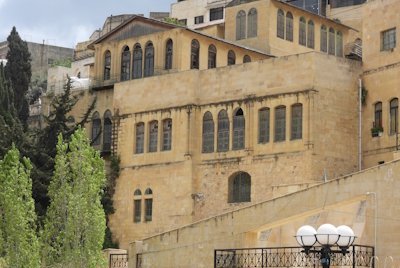
I hadn’t planned on writing a review for this one, but I feel the need to step up for As-Salt a bit, as the current reviews are too harsh. I even believe that people posted gloomy pictures of the site on purpose! I often measure how I like a site by the number of photos I take – there were 101 here, even on a cloudy day and a Friday when many things are closed.
Sure, its OUV is debatable and the overhanging electrical wires and white water tanks have eluded the city’s beautification committee. But do we want the real world to be turned into folk villages? What I found in As-Salt is a homogenous cityscape, built against a hill and made of a distinct yellow, almost golden limestone. Many more original buildings from the late Ottoman period, when As-Salt saw its heydays, have been preserved than I had expected.
In addition to the marked spots by the tourism bureau, I liked the neighbourhood stretching east towards St. George’s Orthodox Church. It takes a bit of climbing but you will be rewarded with good views and some well-preserved traditional buildings. The area has good murals as well, including one that could go for a WH Plaque. Other good spots are the Assumption of Our Lady Catholic Church and the recently renovated residential complexes at Al Ain Square (pictured).
Logistics: I visited around lunchtime on a Friday. There’s little public transport in Amman on Friday mornings, so …
Keep reading 0 comments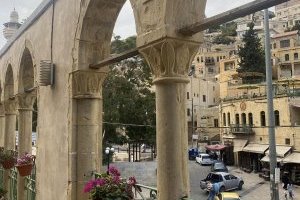
The city itself, like everything in Jordan, is ancient, the name comes from the Latin saltus - forest.But the real prosperity of the city took place at the turn of the 19th and 20th centuries, when the administrative regional center of the Ottoman Empire was located here, and even the independence of Transjordan was declared here in 1922 (but the center of power moved to neighboring Amman later).In order to receive an UNESCO status, As-Salt is presented as a place of peaceful and harmonious coexistence of different religions, because in addition to the Great Mosque, there is also a Latin church, two Orthodox churches, and even an Anglican hospital. It is strongly suspected that the main motive behind the nomination by Jordan was that this city, as the first capital, has a special significance for Jordanian history.
In the tourist center, you can take a booklet with the "route of harmony", which gives at least some sense of place when exploring the city.But I hoped that the Ottoman architecture of the "capital period" would be more interesting, it is modest actually.In fact, it is a suburb of Amman now, so it is easy to get here by car.
Visited November 2022.
Keep reading 0 comments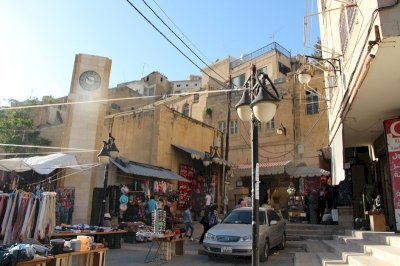
Visit May 19. On my short trip to the northern part of Jordan I visited some great TWHS, like Jerash or Umm al-Jimal. And I visited As-Salt.
I parked my car near the town hall and went to the Archeological Museum. There I got a poorly copied map of the most important buildings related to the WHS. I spent my time hunting down these buildings.
As-Salt is certainly not a city that lets your jaw drop. What Unesco describes as “a blend of European Art Nouveau and Neo-Colonial styles combined with local traditions” were to me rather boring square buildings. The oldest part of the city is not unpleasant, but also not outstanding. Certainly it is not photogenic city. The cars, narrow streets, open cables and lack of real highlights make it hard to get some good shots. Maybe if you find a good guide that can explain the value of the city on site, you get a more satisfying visit. For me, this was absolutely no highlight in a country I otherwise quite like.
As-Salt is very close to Amman. You can easily squeeze it in on your way to the Baptism WHS.
Keep reading 0 comments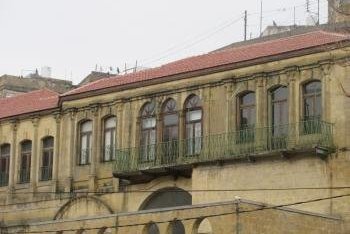
Nowadays As-Salt is nothing more but a satellite city of Amman agglomeration. But until the First World War it was a serious rival of current Jordanian capital. It faced substantial growth particularly in the end of XIXth century, when many wealthy families from the land now called West Bank moved to As-Salt. During this time a Palestinian architect Abdel-Rahman Aqruq formed a new style calle „Arab eclecticism”. As the name suggests, the style was a mix: arabic tradition and european styles (classicism and (neo)gothic are clearly visible, so do secession elements). That style spread over the whole Middle East, which was these days united under Ottoman Empire. Given the importance of this movement, As-Salt will attempt inscription on World Heritage List in 2017.
I visited As-Salt driving from UNESCO site of Bethany beyond the Jordan to Amman. I had very limited time there and the weather was awful so the circumstances were not pleasant. Moreover, it was Friday and the Historical Old Salt Museum was closed. The museum is located in Abu Jaber House, which is probably the most famous expression of the new architectural style. Fortunately, tourist information was open and I was provided with maps proposing several different city walks, such es 'educational' or 'harmony' trail. Although they are interesting, none of them is exactly related to the potential iscription as a WHS. However, the most important buildings in the old town are supported with a plaque describing interesting facts and showing the distance to the next interesting …
Keep reading 0 comments
